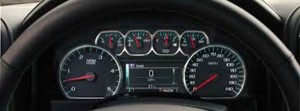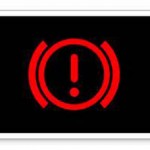Home »

Dashboard warning lights you must heed
 The dashboard of a modern truck or car is often an exciting mixture of lights, numbers and symbols and as such some drivers stop paying attention to them.
The dashboard of a modern truck or car is often an exciting mixture of lights, numbers and symbols and as such some drivers stop paying attention to them.
However, one should always pay attention to dashboard warning lights that come on when your vehicle needs immediate attention.
 Some of the most important warning lights to heed are: Check Engine Soon (Malfunction Indicator Lamp); ABS-Brake system; Tire Pressure Monitor System; and your Airbag light, says Jordan Fiorentino, shop foreman at Cranbrook’s Northstar GM (Pictured left).
Some of the most important warning lights to heed are: Check Engine Soon (Malfunction Indicator Lamp); ABS-Brake system; Tire Pressure Monitor System; and your Airbag light, says Jordan Fiorentino, shop foreman at Cranbrook’s Northstar GM (Pictured left).
“There might be people out there who don’t really know much about them or don’t even know what they mean,” Fiorentino said, suggesting that when lights do come on, drivers should immediately find out what the light means by consulting their vehicle manual or head to their local mechanical expert.
“Warning lights and gauges can signal that something is wrong before it becomes serious enough to cause an expensive repair or replacement,” Fiorentino said, offering the following advice.

– Paying attention to the warning lights and gauges could prevent injury.
– Warning lights come on when there could be a problem with a vehicle function. Some warning lights come on briefly when the engine is started to indicate they are working.
– Gauges can indicate when there could be a problem with a vehicle function. Often gauges and warning lights work together to indicate a problem with the vehicle.
– When one of the warning lights comes on and stays on while driving, or when one of the gauges shows there may be a problem. Waiting to do repairs can be costly and even dangerous.
The vehicle brake system consists of two hydraulic circuits. If one circuit is not working, the remaining circuit can still work to stop the vehicle. For normal braking performance, both circuits need to be working, Fiorentino said.
“If the warning light comes on, there is a brake problem. Have the brake system inspected right away. This light should come on briefly when the engine is started. If it does not come on then, have it fixed so it will be ready to warn if there is a problem,” he said.
 When the ignition is on, the brake system warning light also comes on when the parking brake is set. The light stays on if the parking brake does not fully release. If it stays on after the parking brake is fully released, it means the vehicle has a brake problem.
When the ignition is on, the brake system warning light also comes on when the parking brake is set. The light stays on if the parking brake does not fully release. If it stays on after the parking brake is fully released, it means the vehicle has a brake problem.
“If the light comes on while driving, pull off the road and stop carefully. The pedal might be harder to push, or the pedal can go closer to the floor. It may take longer to stop. If the light is still on, have the vehicle towed for service,” Fiorentino said.
Warning: The brake system might not be working properly if the brake system warning light is on. Driving with the brake system warning light on can lead to a crash. If the light is still on after the vehicle has been pulled off the road and carefully stopped, have the vehicle towed for service.
 Antilock Brake System (ABS) Warning Light
Antilock Brake System (ABS) Warning Light
This light comes on briefly when the engine is started.
– If the light does not come on, have it fixed so it will be ready to warn if there is a problem.
 – If the ABS light stays on, turn the ignition off.
– If the ABS light stays on, turn the ignition off.
– If the light comes on while driving, stop as soon as it is safely possible and turn off the vehicle. Then start the engine again to reset the system. If the ABS light stays on, or comes on again while driving, the vehicle needs service. A chime may also sound when the light comes on steady.
 – If the ABS light is the only light on, the vehicle has regular brakes, but the antilock brakes are not functioning.
– If the ABS light is the only light on, the vehicle has regular brakes, but the antilock brakes are not functioning.
– If both the ABS and the brake system warning light are on, the vehicle’s antilock brakes are not functioning and there is a problem with the regular brakes. See your dealer for service.
When a low tire pressure condition is detected, the TPMS illuminates the low tire pressure warning light located on the instrument cluster. If the warning light comes on, stop as soon as possible and inflate the tires to the recommended pressure shown on the Tire and Loading Information label, Fiorentino pointed out.
 A message to check the pressure in a specific tire displays in the Driver Information Center (DIC). The low tire pressure warning light and the DIC warning message come on at each ignition cycle until the tires are inflated to the correct inflation pressure.
A message to check the pressure in a specific tire displays in the Driver Information Center (DIC). The low tire pressure warning light and the DIC warning message come on at each ignition cycle until the tires are inflated to the correct inflation pressure.
If the vehicle has DIC buttons, tire pressure levels can be viewed.
 “The low tire pressure warning light may come on in cool weather when the vehicle is first started, and then turn off as the vehicle is driven. This could be an early indicator that the air pressure is getting low and needs to be inflated to the proper pressure,” Fiorentino pointed out.
“The low tire pressure warning light may come on in cool weather when the vehicle is first started, and then turn off as the vehicle is driven. This could be an early indicator that the air pressure is getting low and needs to be inflated to the proper pressure,” Fiorentino pointed out.
A Tire and Loading Information label shows the size of the original equipment tires and the correct inflation pressure for the tires when they are cold.
The TPMS can warn about a low tire pressure condition but it does not replace normal tire maintenance.
“Tire sealant materials are not all the same. A non-approved tire sealant could damage the TPMS sensors. TPMS sensor damage caused by using an incorrect tire sealant is not covered by the vehicle warranty,” Fiorentino said. “Always use only the GM approved tire sealant available through your dealer or included in the vehicle.”
A computer system called OBD II (On-Board Diagnostics-Second Generation) monitors the operation of the vehicle to ensure emissions are at acceptable levels, helping to maintain a clean environment. The malfunction indicator lamp comes on when the vehicle is placed in ON/RUN, as a check to show it is working. If it does not, have the vehicle serviced by your dealer.
 “If the malfunction indicator lamp comes on while the engine is running, this indicates that the OBD II system has detected a problem and diagnosis and service might be required, Fiorentino said, adding, “Malfunctions often are indicated by the system before any problem is apparent. Being aware of the light can prevent more serious damage to the vehicle. This system also assists the service technician in correctly diagnosing any malfunction.”
“If the malfunction indicator lamp comes on while the engine is running, this indicates that the OBD II system has detected a problem and diagnosis and service might be required, Fiorentino said, adding, “Malfunctions often are indicated by the system before any problem is apparent. Being aware of the light can prevent more serious damage to the vehicle. This system also assists the service technician in correctly diagnosing any malfunction.”
 If the vehicle is continually driven with this light on, the emission controls might not work as well, the vehicle fuel economy might not be as good, and the engine might not run as smoothly. This could lead to costly repairs that might not be covered by the vehicle warranty, he said.
If the vehicle is continually driven with this light on, the emission controls might not work as well, the vehicle fuel economy might not be as good, and the engine might not run as smoothly. This could lead to costly repairs that might not be covered by the vehicle warranty, he said.
Modifications made to the engine, transmission, exhaust, intake, or fuel system of the vehicle or the replacement of the original tires with other than those of the same Tire Performance Criteria (TPC) can affect the vehicle’s emission controls and can cause this light to come on.
 Modifications to these systems could lead to costly repairs not covered by the vehicle warranty. If none of the above have made the light turn off, your dealer can check the vehicle. The dealer has the proper test equipment and diagnostic tools to fix any mechanical or electrical problems that might have developed, Fiorentino advised.
Modifications to these systems could lead to costly repairs not covered by the vehicle warranty. If none of the above have made the light turn off, your dealer can check the vehicle. The dealer has the proper test equipment and diagnostic tools to fix any mechanical or electrical problems that might have developed, Fiorentino advised.
– This article published courtesy Northstar GM, 1816 Cranbrook Streek North, Cranbrook.










